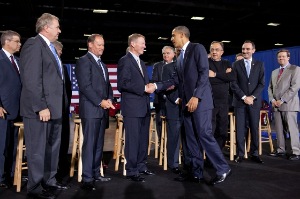 On July 29, President Obama announced the next phase in the Administration’s program to increase fuel efficiency and reduce greenhouse gas pollution for all new cars and trucks sold in the United States.
On July 29, President Obama announced the next phase in the Administration’s program to increase fuel efficiency and reduce greenhouse gas pollution for all new cars and trucks sold in the United States.
According to the White House, automaker fleets will now have to average 54.5 miles per gallon by 2025. This is about 2 mpg less than the earlier fuel-economy target of 56.2 mpg that was proposed by the Obama Administration.
The 2017-2025 rule will begin to take effect in 2017. Fuel economy standards, often referred to as “CAFE” (corporate average fuel economy), for new vehicles are already slated to improve from an average of 27.3 mpg today, to 35.5 mpg by 2016.
The 2017-2025 rule is expected to include credits for the automakers that incorporate some of the latest vehicle technology for reducing fuel consumption, such as engine shut-off during idling and specially designed louvered front grilles.
While automakers feel the new mpg number is within reach, David Champion, the senior director of Consumer Reports’ auto test division, favored the original target.
"A minimum standard of 56 miles per gallon is definitely good for consumers and currently achievable, but 62 is even better. Technologies to attain this level of improvement exist, and the automakers can incorporate them over the next 15 years.”
According to Champion, these advanced technologies are currently on the market today. “In our testing, we’ve already seen highway consumption of 55 mpg in a Toyota Prius hybrid and 49 mpg in a Volkswagen Golf diesel.”
According to Consumer Reports’ findings, moving to 62 mpg by 2025 was estimated to save consumers about $6,000 in owner costs over the life of the vehicle and cut U.S. gasoline consumption by one-third.
A recent Consumer Reports survey said car buyers want better fuel economy and are willing to pay for it. In fact, 62% of survey respondents said when they buy their next car, they expect to choose a model with better gas mileage than their current car, and 58% said they were willing to pay extra money for a more fuel-efficient vehicle.
According to the White House new standards will help consumers save an estimated $1.7 trillion dollars in real fuel costs over the life of their vehicles.
By 2025, the standards are projected to save families an estimated $8,200 in fuel savings over the lifetime of a new vehicle, relative to the Model Year 2010 standard.
The White House reported that one of the biggest reasons for the new standards is to redyuce oil dependence.
"As our cars and trucks become more fuel efficient, we will need to use less oil. Over the life of the program, the standards will save an estimated 12 billion barrels of oil – nearly four years’ worth of consumption by light-duty vehicles at current levels," Obama said.
By 2025, the standards for MY 2011-2025 will reduce oil consumption by an estimated 2.2 million barrels a day – more than we import from any country other than Canada.
As the vehicle fleet turns over and older vehicles are replaced with more efficient ones, the oil savings from these standards will grow, ultimately reaching over 4 million barrels a day – nearly as much as we import from all OPEC countries combined.
The MY 2011-2025 standards are critical to meeting President Obama’s goal of cutting oil imports by one-third by 2025, contributing over half the savings needed to meet the President’s goal.
We would like to hear from you. Do you think that the automakers will have trouble reaching the 54.5 mpg target within the next 14 years?
How do you think this will affect your work as an automotive technician or shop owner? Do you think the increasing technology will cause more or fewer service-related problems for your customers’ vehicles? E-mail us at [email protected].
Sources: Reuters news, The White House and Consumer Reports












